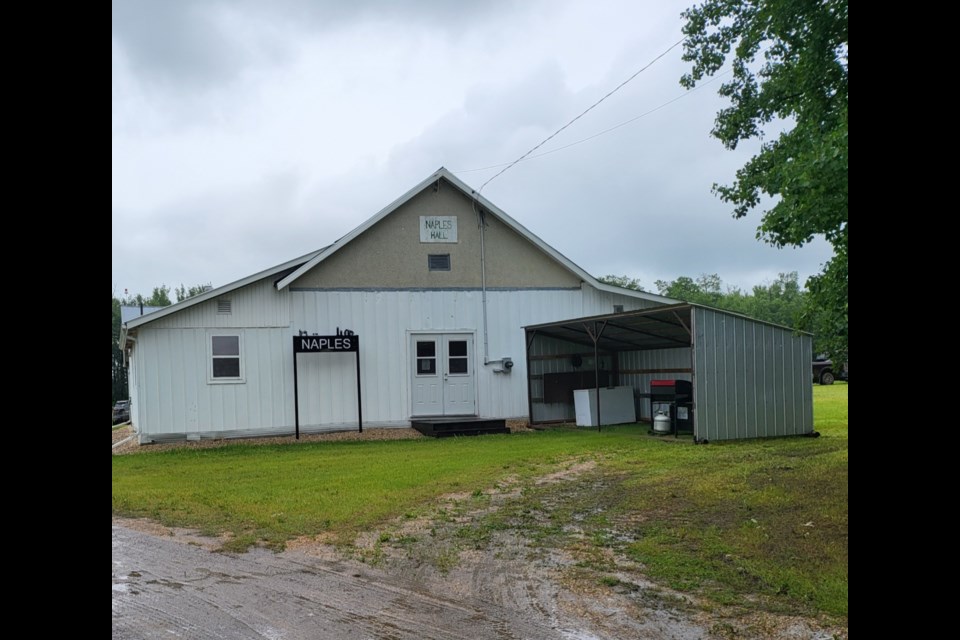BARRHEAD – The Naples Hall turns 100 years old this year, and the community celebrated with a three-day event on June 13, 14, and 15 with games, memorabilia, fantastic food and reminiscing.
Eugene Messmer, one of the oldest people in the area, born in 1932, provided the history of the hall.
“All the community members worked together to build the hall,” said Eugene Messner.
People in the community took settler’s permits for timber in 1924.
The timber was cut down three miles straight north of the original hall site on crown land and was used to be build the original one room hall in 1925.
Bill Saline had a sawmill in the area where the logs were taken to be cut into boards for the hall.
Alec Barber was a journeyman carpenter who immigrated to the area and led the construction of the hall according to Eugene Messmer.
Naples Hall was built on the school grounds.
When Eugene Messmer was young kids used to play in the hall, especially in the winter.
Some of the teachers were worried that the kids would damage something and one day the piano was toppled over.
The kids righted the piano, and Eugene Messmer is pretty sure no one knew about the incident.
Eugene Messmer’s uncle, Ernest, donated the land where the hall stands today.
They moved the main part of the building with Sam Howley’s D8 Cat and a couple of big logs in 1954 and Messmer helped with the move.
It took over a week to prepare the building for relocation, including taking off the kitchen portion, and around 4 hours to move the building to its new home.
“I was raised here. We slept in the coat room most of the time while everyone partied until whatever time,” said Tim Messmer, Naples Hall Chairperson and Eugene Messmer’s son.
“When we were kids, they were doing something almost every weekend.”
Once he was married, they moved back out to the area and was taught how to maintain the hall and what needed to be done.
The Messmers have been in the area since 1912 and the Properzis were already in the area when the Messmers arrived.
Naples Hall was moved because they couldn’t get power at the original site back in those times said Joyce Properzi.
She remembers when she was 14 years old and she had to spend the night at the hall all alone. She slept on a bench.
Her family lived close by, and someone needed to keep the wood and coal stoves going to keep the hall warm so they could have a social the next day.
The 4H was very active in the hall and Joyce was a 4H leader for 21 years.
Donald Properzi remembers the old-time picnics and merry-go-rounds with live ponies.
The Farmer’s Day picnic used to make it rain, said Donald Properzi.
Kenny Properzi recalls the Bingo tents where chocolate bars were the prizes while the kids all ran around.
Linda DeYoung (née Properzi) recalls that every quarter had a family on it where that doesn’t exist anymore.
All of the original families were like one big family recalls DeYoung.
Horse tournaments were very competitive and got heated with laser-accurate throws from the players.
There were many baseball and softball tournaments.
Mike Anderson grew up in Freedom, a neighbouring community, and he used to come to the dances.
Anderson pointed out that nowadays you drink in the hall and smoke outside and in the old days it was the other way around where you smoked inside and went outside to drink.
There was a story about the night of a dance where someone through a dead skunk in a garbage bag in through the north door and cleared out the place because of the smell.
There was a hockey rink at the hall at one time where anyone with a hockey stick played.
There was a display of memorabilia, including the property owner's lot map from 1908 and 1923, showing many of the original families in the area.
A picture of the very first picnic in 1925 with six families was display, done by a photographer to capture the event.
Many of the first families were from Italy, all from different areas, speaking their own dialect as per DeYoung.
The order catalogue from the 1920s from the local store was there, well-worn with use.
Pictures of the school and the coal mine were also displayed.
The coal mines were started by Eugene Messner’s dad and uncles in 1933 to create jobs for people in the community.
The coal was only about 15 feet underground and it was hands and knees work, wearing the knees of workers’ pants off.
The mine was eventually sold to a Westlock man who abandoned the mine in time.


.jpg;w=120;h=80;mode=crop)
